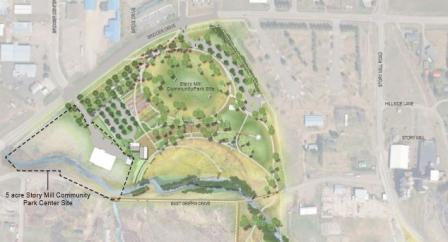The Story of Story Mill-A Montana Community Working to Restore Wetlands
Update: The Trust for Public Land became the recipient of the 2017 Wetland Stewardship Award for the Story Mill Community Park. The award was given by the Montana Wetland Council.
Story Mill, a 55-acre site on the outskirts of Bozeman, Montana, has undergone several transformations in recent history. The place is virtually a “mill of stories” with respect to land use, but originally it was a wetland. In 1882, Nelson Story built a water-powered mill along with the largest grain elevator in the state. Filling in wetlands was necessary to make way for barns, as agriculture became the most important industry. After being abandoned in the 1950’s the barns fell into disrepair for decades to come. Due to sudden bankruptcy, the plans for intensive residential and commercial development in the 2000’s also fell through. However, it did open the door for public, private and nonprofit organizations to come together and create a plan to return the landscape to its original form of a wetland.
Story Mill is located in a wildlife corridor between two mountain ranges. Restoration will thus improve habitat for the many birds, beavers, otters, and mink that live there. The Sacajawea Audubon Society recently counted over 100 bird species on-site, including nesting Sandhill cranes, meaning the site is an excellent habitat for local wildlife populations. The location makes it an ideal wetland restoration site at the intersection of two urban streams, the East Gallatin River and Bozeman Creek. Restoring the wetland also promotes overall downstream water health and will improve the trout fishery in the East Gallatin River, the most popular trout-fishing creek. Restoration contractors have reconnected Bozeman Creek to its floodplain, creating Bozeman Creek Slough. Bozeman’s Public Works Director, Craig Woolard, praises this project as a green addition to the city’s storm water system because during heavy rains rainwater will run off roads and pavement into the slough where sediment will be filtered, allowing for cleaner water to continue down Bozeman Creek.
The Story Mill Community Park adjacent to the restored wetland will include hiking trails, interpretive programs, and a public access point to the river. An additional twenty acres of higher ground at the front of the site will include playgrounds, visitor facilities and community gathering spaces themed around exploration and contemplative outdoor experience. Already, Story Mill is serving as an “outdoor classroom” for Bozeman’s youth and university students as children go to camps at the site to learn about restoration efforts and park design. Soil science and water engineering classes from Montana State University have also come to study the restoration project and one Master’s of Science student is even doing her thesis on nutrient cycling there.
The Trust for Public Land (TPL) acquired the Story Mill property in 2012 and in 2013 a working group of city, state, private and nonprofit groups began meeting monthly to plan and implement the Story Mill Restoration Project. The TPL, Montana Fish, Wildlife and Parks, Greater Gallatin Watershed Council, the Gallatin Local Water Quality District, Trout Unlimited and Montana Department of Environmental Quality Exithave worked together in unison and each has contributed their expertise. The EPA contributed funding to the development of the restoration plan as well as educational materials to the water quality monitoring process. In the spring of 2013, Montana Department of Environmental Quality started baseline water quality monitoring, installing groundwater wells that the Greater Gallatin Watershed Council’s AmeriCorps volunteers monitor weekly. The Watershed Council’s volunteer ‘Stream Teams’ have added two stream water monitoring sites. The Bozeman City Commission approved the plan for the city park in spring of 2014 and groundbreaking restoration began that fall. When completed, the restoration project will excavate the river floodplain in three areas and double in size to approximately 15 acres of the footprint of the existing wetland, creating a place for wildlife and residents alike to enjoy the outdoors.
Maddy Pope, who manages the project for the TPL, points out “restoration often occurs on private lands. This is unique because it’s public, and so accessible.” The Story Mill Community Park, slated to open in fall 2018, will allow park visitors to explore the restored landscape and experience firsthand the value of conserving wetlands to protect urban water quality. For years to come, families will be able to walk, learn and play in the green, urban haven where wildlife walk, swim and fly

